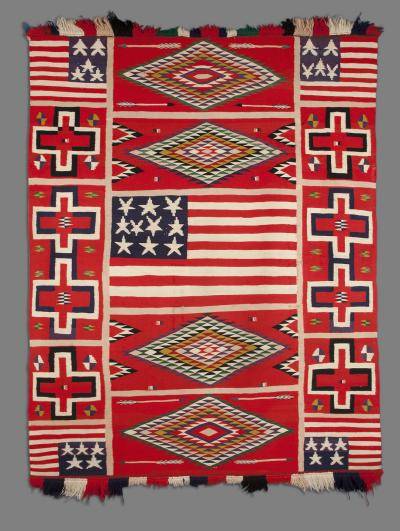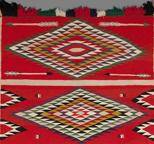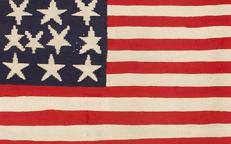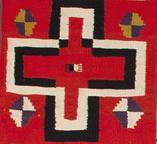Students will become familiar with the weaving process and create a paper weaving that includes designs inspired by the Navajo Eyedazzler Blanket/Rug.
Students will be able to:
- discuss the cultural significance of the Eyedazzler Blanket/Rug;
- use academic vocabulary associated with the weaving process;
- develop a design within a limited color palette;
- demonstrate the weaving process; and
- create a unique work of art based on knowledge gained.
Lesson
- Show students the image of the Eyedazzler Blanket/Rug and ask them to describe what they see. Ask students what colors they see and which color is used the most.
- Describe and define what a symbol is if students are unfamiliar with the term. Ask students to point out what symbols they see in the blanket. Have they ever seen similar ones? If so, where?
- Point out that this is called an Eyedazzler Blanket/Rug because of the dazzling and interesting symbols, designs, and colors. Ask students if their eyes are dazzled by a particular design.
- Tell students that this is a weaving that was made on a loom. Show them an image of a loom or an artist working on a loom. Point out the loom, the warp, and the decorative weft, and explain the purpose of each to the overall weaving.
- If you have Internet access, you could also show a portion of the short video of a Navajo weaver and her loom included the "Teaching Resources" section of the Eyedazzler Blanket/Rug object page. Please preview this video if you plan to show the whole thing to your class to make sure it is age and content appropriate.
- Describe the over-under weaving process. Explain that if one row starts with over and then under, the next row would start with under and then over.
- Share information from About the Art with students as is appropriate. Point out the details described in the “Details” section, such as the fact that the brightly colored Germantown yarns used in this blanket were readily available at trading posts and therefore are typical of blankets/rugs from this era.
- Give each student a 12x18-inch piece of construction paper. Let students choose from a limited palette of colors similar to those found in the Eyedazzler Blanket/Rug. Explain that this color will be their warp, or what they weave through.
- Instruct students to turn their papers horizontally and use a ruler to draw a line across the top of the paper. The width of the space between the top of the paper and this line should be the same as the width of the ruler. Demonstrate this for students. Explain that this is the stop line.
- Demonstrate how to start at the bottom of the horizontal piece of paper and cut lines up to the stop line, making 8 or 9 cuts so that the paper now has fringe. The cuts could be straight or wavy.
- Give each student about 11 of the 1x18-inch strips of paper cut from the same color palette as the Eyedazzler Blanket/Rug. This will be their weft, or the decorative part of the weaving.
- Demonstrate how to weave a weft strip over and under the warp strips, and then push the weft strip up to the top of the paper. Weave the next strip in an alternating manner. Younger students may find this difficult depending on their motor skills. It might be beneficial to group them so that there is a helper with each group. You might also want to put a piece of tape at the top of the warp to hold it down on the table while weaving.
- After the weaving is finished, glue the end and side strips so that it can’t fall apart.
- Optional: If time allows, provide oil pastels in the same Navajo color palette to allow students to add eye-dazzling symbols or designs to their weaving.
- Optional: For older students, you might consider using a cardboard loom, cotton twine for a warp, and colored yarn for a weft. They may even be able to weave simple symbols into the weft with yarn using a yarn needle.
Materials
- 12x18-inch construction paper in the limited color palette found in the Eyedazzler Blanket/Rug, one piece for each student
- 1x18-inch strips of construction paper in the same limited color palette, about 11 strips for each student
- Rulers
- Pencils
- Scissors
- Glue or glue sticks
- Images of looms and weavings, or access to a real loom and weavings
- About the Art section on the Eyedazzler Blanket/Rug
- Color copies of the Eyedazzler Blanket/Rug for students to share, or the ability to project the image onto a wall or screen
Optional:
- Tape
- Oil pastels or crayons that will show on construction paper
- For older students: cardboard looms, cotton twine, yarn, and yarn needles
Standards
- Social Studies
- History
- Visual Arts
- Invent and Discover to Create
- Observe and Learn to Comprehend
- Relate and Connect to Transfer
- Envision and Critique to Reflect
- Language Arts
- Research and Reasoning
- Collaboration
- Critical Thinking & Reasoning
- Information Literacy
- Invention
- Self-Direction

Eyedazzler Blanket/Rug
Artist not known, Navajo, United States
About 1885
Length: 71in. Width: 54 in.
Gift of Mrs. Charles Macallister Willcox, 1937.306
Photograph © Denver Art Museum 2012. All Rights Reserved.
This blanket/rug was likely the work of a female Navajo artist. Loom weaving was a woman’s art among the Navajos after they learned the skill from their Pueblo neighbors in the 1600s, but today both men and women weave.
Navajo weavers are justly famous for the excellence of their textiles. This style, known as an eyedazzler because of its vivid colors and dizzying design combinations, was popular during the later years of the Transitional period in Navajo weaving (1868–90), when artists began weaving for the tourist market rather than solely for home use. Brightly colored “Germantown” yarns, widely available through newly established trading posts on the Navajo Reservation, made it possible to produce these vibrant masterpieces.
During the Transitional period (1868–90) when this blanket/rug was created, Navajo weavers began to produce patterns compatible with the tastes of traders and patrons. Eyedazzler weavings are uniquely Navajo innovations, created to take advantage of a range of commercially made colors not previously available. In some ways you can think of these artists as testing a new product on a new audience.
Although this rectangular weaving is called a blanket or a rug, the decorative fringe and cotton warp (cotton is less durable than wool) suggest that its maker knew it was more likely to be displayed on a wall for decoration than to be used.
Details

The Bold Red
The red wool used throughout the background is a kind of commercially manufactured yarn called Germantown, named after a town in Pennsylvania that produced these yarns using synthetic dyes.

Saltillo Diamond
Navajo artists borrowed the serrated diamond motif from New Mexican Saltillo serapes. The Navajo people became familiar with the motif when they were incarcerated at Bosque Redondo in New Mexico (1863–68), where they received Saltillo-style blankets from the United States government.

Flags
Five flags appear in this eyedazzler. Notice how the artist used them to mimic the look of the American flag but not duplicate it exactly. Navajo weavers of this time often used flags in their textiles as design elements to appeal to non-Navajo customers.

Crosses
Artists often included cross-shaped designs in their eyedazzlers. Despite the obvious association with Christianity, these designs may have been derived from traditional Navajo women’s dresses.
Funding for object education resources provided by a grant from the Morgridge Family Foundation. Additional funding provided by the William Randolph Hearst Endowment for Education Programs, and Xcel Energy Foundation. We thank our colleagues at the University of Denver Morgridge College of Education.
The images on this page are intended for classroom use only and may not be reproduced for other reasons without the permission of the Denver Art Museum. This object may not currently be on display at the museum.







